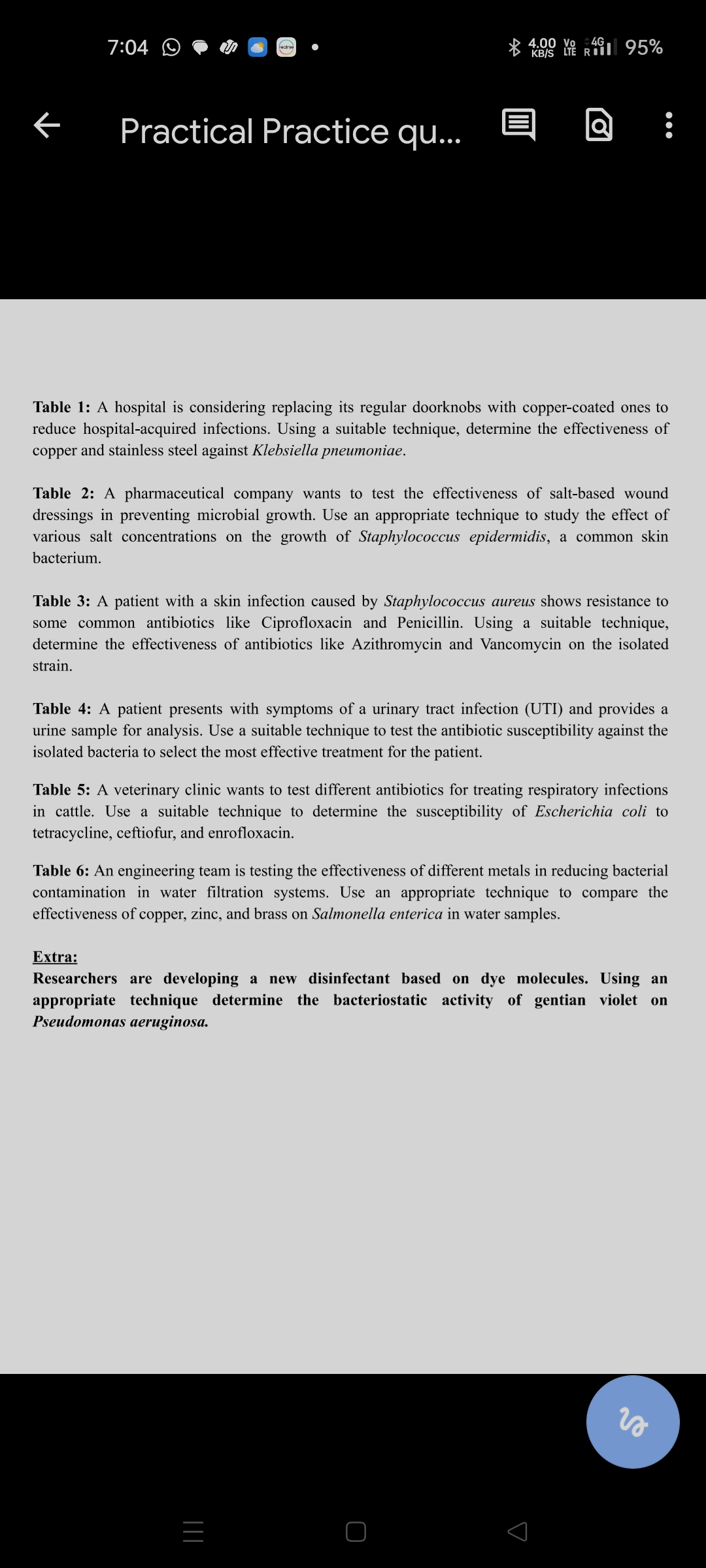A hospital is considering replacing its regular doorknobs with copper-coated ones to reduce hospital-acquired infections. Using a suitable technique, determine the effectiveness of... A hospital is considering replacing its regular doorknobs with copper-coated ones to reduce hospital-acquired infections. Using a suitable technique, determine the effectiveness of copper and stainless steel against Klebsiella pneumoniae. A pharmaceutical company wants to test the effectiveness of salt-based wound dressings in preventing microbial growth. Use an appropriate technique to study the effect of various salt concentrations on the growth of Staphylococcus epidermidis, a common skin bacterium. A patient with a skin infection caused by Staphylococcus aureus shows resistance to some common antibiotics like Ciprofloxacin and Penicillin. Using a suitable technique, determine the effectiveness of antibiotics like Azithromycin and Vancomycin on the isolated strain. A patient presents with symptoms of a urinary tract infection (UTI) and provides a urine sample for analysis. Use a suitable technique to test the antibiotic susceptibility against the isolated bacteria to select the most effective treatment for the patient. A veterinary clinic wants to test different antibiotics for treating respiratory infections in cattle. Use a suitable technique to determine the susceptibility of Escherichia coli to tetracycline, ceftiofur, and enrofloxacin. An engineering team is testing the effectiveness of different metals in reducing bacterial contamination in water filtration systems. Use an appropriate technique to compare the effectiveness of copper, zinc, and brass on Salmonella enterica in water samples. Researchers are developing a new disinfectant based on dye molecules. Using an appropriate technique, determine the bacteriostatic activity of gentian violet on Pseudomonas aeruginosa.

Understand the Problem
The question presents various scenarios related to the effectiveness of different treatments and materials against bacterial infections and resistances. It asks for appropriate techniques to analyze and determine effectiveness in each case. The high-level approach involves selecting suitable microbiological tests for evaluating the effectiveness of disinfectants, antibiotic susceptibility, and antimicrobial properties of materials.
Answer
Use disk diffusion, plating, and dilution methods for testing effectiveness against specific bacteria.
Use disk diffusion or plating methods to test copper and stainless steel against Klebsiella pneumoniae. Salt concentration effects on Staphylococcus epidermidis can be determined using broth or agar dilution. Use disk diffusion for Staphylococcus aureus and E. coli antibiotic susceptibility tests. Employ microdilution for gentian violet effects on Pseudomonas aeruginosa.
Answer for screen readers
Use disk diffusion or plating methods to test copper and stainless steel against Klebsiella pneumoniae. Salt concentration effects on Staphylococcus epidermidis can be determined using broth or agar dilution. Use disk diffusion for Staphylococcus aureus and E. coli antibiotic susceptibility tests. Employ microdilution for gentian violet effects on Pseudomonas aeruginosa.
More Information
Copper surfaces have been shown to significantly reduce bacterial viability compared to stainless steel, making them effective in preventing hospital-acquired infections.
Tips
When using disk diffusion, ensure agar is poured uniformly to avoid uneven diffusion and incorrect readings.
Sources
- Antiviral surfaces and coatings - nature.com
- Copper alloys - The new 'old' weapon - miscimages-2.s3.amazonaws.com
- Antibacterial and Antiviral Functional Materials - pmc.ncbi.nlm.nih.gov
AI-generated content may contain errors. Please verify critical information